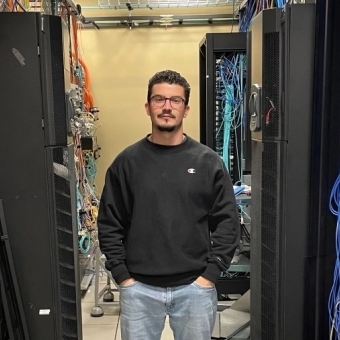A Day in the Life of a Cybersecurity Professional

The field of cybersecurity is vast and expanding. Cybersecurity professionals work in a variety of fields and sectors. Once you earn a master of science (M.S.) degree in Cyber and Information Security, there are many career paths you can pursue.
If you are interested in one of these careers, you may wonder what a day in the life of a cybersecurity professional actually looks like.
A typical day in cybersecurity likely includes
High-level responsibilities such as
- Conducting risk analysis
- Coordinating with other departments
- Developing security strategies
- Evaluating and updating systems
- Setting security standards
Daily tasks such as
- Monitoring systems
- Testing for vulnerabilities
- Training other employees
- Updating patches
- Writing incident reports
Critical issue responses such as
- Activating protocols in response to breaches
- Promptly addressing cyber threats
- Remediating any issues
Cybersecurity Analyst Sample Work Schedule
One of the top roles for cybersecurity professionals is a cybersecurity analyst. A cybersecurity analyst is a trained professional who is responsible for protecting an organization’s data, systems, and networks from cyber threats, security breaches, and hacking.
In general, cybersecurity professionals typically work standard full-time hours or around 40 hours per week in a full-time role. However, due to the nature of the cybersecurity field, some work may be required outside of regular business hours to respond to urgent security incidents and threats.
Here’s what a day as a cybersecurity analyst might look like.
9–10 a.m. Answer emails, review priorities, do routine system checks
10–11 a.m. Meet with information technology/cyber team to discuss new protocols and timeline
11 a.m.–Noon Monitor networks for security breaches and identify potential vulnerabilities
Noon–1 p.m. Lunch
1–3 p.m. Install new software and write training information/documentation for coworkers
3–4 p.m. Write a security report from the previous month and develop slide deck for presenting it to the team
4–5 p.m. Test the new software installation/check status and make a to-do list for the next day
Cybersecurity and Work/Life Balance
While cyber and information security jobs may require on-demand work when threats arise, cyber professionals can still achieve work/life balance. Many cybersecurity jobs can be fully remote, allowing you to skip the commute and manage household tasks or personal projects on breaks. Depending on the industry or sector in which you pursue a cybersecurity role, you may also have time off or vacation time packages, or the ability to flex hours when you do have to be on call.
When applying for a cybersecurity role, ask questions like
Am I able to work remotely?
Do you offer flexible work hours?
How much paid time off is offered?
What is the company culture when it comes to work/life balance?
Finding Fulfillment in a Cybersecurity Career
As a cybersecurity professional, you have the skills to help organizations, businesses, and communities secure their data and reach their goals. Because the demand for cybersecurity reaches virtually every industry, you may be able to combine interests or passions when searching for a job. For instance, you could work for the government securing top-secret information, help school districts secure student data, or help your favorite sports team ensure their ticket system is hacker-proof.
“I am passionate about innovative approaches to information security—building and developing networks both personally and professionally—and believe in working collectively for the growth of any organization in which I am involved,” says Joel Ndimkora ’12C, ’22CCPS, who manages information security in the defense industry, while simultaneously serving in the US Army to secure the country against cyberspace adversaries.
With a skillset that is highly transferable and relevant, you’re guaranteed to never get bored. An M.S. in Cyber and Information Security can help you change industries or jobs and take on exciting projects.
Since technology changes at a rapid pace, cybersecurity professionals must be committed to lifelong learning and problem solving.
Alumni Spotlight: Tackling Ever-Changing Challenges in Cybersecurity
“Technology is an ever-changing field; we fix things one day for it to break the next. It speaks strongly to those who enjoy a challenge,” says Marc A. Zirillo ’18CPS, ’23MS, Information Technology Specialist at the Nassau BOCES Security Operations Center.
“Constantly learning is part of the job, and just as cyber threats evolve, so must the defenders of data. The cybersecurity program at St. John’s aided me in cultivating a holistic toolbelt to attack this ever-present threat.”
Staying ahead in Cybersecurity
For a long-term career in cybersecurity, continued education may be required to stay on top of ever-changing technologies. For students and alumni of programs like the M.S. in Cyber and Information Security from St. John’s University, there are many resources available to stay in the know.
Events and seminars offered by St. John’s cover trending and relevant topics such as
- Generative AI and Cybersecurity
- Cybersecurity in a Global Context
- CyRM: Mastering the Management of Cybersecurity Risk
- Expert-led Discussions on the Impact of Cybercrime
Building a network of professionals and resources will help you elevate your day-to-day as a cybersecurity expert and keep your career exciting for years to come.






